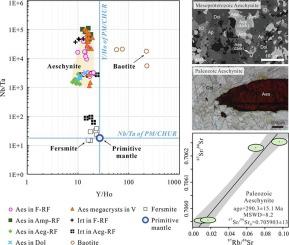当前位置:
X-MOL 学术
›
Precambrian. Res.
›
论文详情
Our official English website, www.x-mol.net, welcomes your feedback! (Note: you will need to create a separate account there.)
Hydrothermal genesis of Nb mineralization in the giant Bayan Obo REE-Nb-Fe deposit (China): implicated by petrography and geochemistry of Nb-bearing minerals
Precambrian Research ( IF 3.8 ) Pub Date : 2020-09-01 , DOI: 10.1016/j.precamres.2020.105864 Shang Liu , Lin Ding , Hong-Rui Fan , Kui-Feng Yang , Yan-Wen Tang , Hai-Dong She , Mei-zhen Hao
Precambrian Research ( IF 3.8 ) Pub Date : 2020-09-01 , DOI: 10.1016/j.precamres.2020.105864 Shang Liu , Lin Ding , Hong-Rui Fan , Kui-Feng Yang , Yan-Wen Tang , Hai-Dong She , Mei-zhen Hao

|
Abstract The Bayan Obo REE-Nb-Fe deposit, which reserves the current largest REE resources globally, also hosts over 70% of China’s Nb resources. Unlike many world-class carbonatite-related Nb deposits (e.g. Morro dos Seis Lagos and Araxa, Brazil) with igneous or secondary origin, Nb was mainly stored in Nb-bearing minerals (aeschynite, ilmenorutile, baotite, fergusonite etc.) of hydrothermal origin at Bayan Obo, supported by evidence from petrography, element and isotopic geochemistry. Although igneous fersmite and columbite were occasionally discovered in local carbonatite dykes, the Mesoproterozoic and Paleozoic hydrothermal metasomatism occurred in the ore-hosting dolomite, related to carbonatite intrusion and the closure of Paleo-Asian Ocean respectively, has played a more significant role during the ultimate Nb enrichment. REE, however, was significantly enriched during both the carbonatite-related magmatic and hydrothermal processes. Consequently, there was differentiated mineralization between REE and Nb in the carbonatite dykes and the ores. Niobium mineralization at Bayan Obo is rather limited in Mesoproterozoic carbonatite, whereas more extensive in the metasomatized ore-hosting dolomite, and generally postdating the REE mineralization at the same stage. According to mineral geochemistry, Bayan Obo aeschynite was classified into 3 groups: aeschynite-(Nd) with convex REE patterns (Group 1); aeschynite-(Ce) (Group 2) and nioboaeschynite (Group 3) with nearly flat REE patterns. Aeschynite (Group 1), ilmenorutile and fergusonite precipitated from Paleozoic hydrothermal fluids with advanced fractionation of Ce-rich REE minerals. The Mesoproterozoic hydrothermal Nb mineralization, represented by aeschynite (Group 3) and baotite, occurred postdating REE mineralization at same stage. Besides, fersmite and aeschynite (Group 2) precipitated from the Mesoproterozoic REE-unfractionated melt and hydrothermal fluids, respectively. All above Nb-bearing minerals exhibit extreme Nb-Ta fractionation as a primary geochemical characteristic of mantle-derived carbonatite. The forming age of the aeschynite megacrysts (Group 1) has not been accurately determined. However, the potential age was constrained to ~430 Ma or alternatively ~270–280 Ma subjected to subduction and granite activity, respectively. These aeschynite crystals inherited REEs from multiphase former REE mineralization, with an intermediate apparent Sm-Nd isochron age between the Mesoproterozoic and the Paleozoic REE mineralization events.
更新日期:2020-09-01


























 京公网安备 11010802027423号
京公网安备 11010802027423号